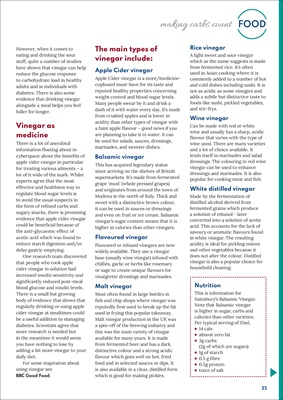
35
FOOD
making carbs count
However, when it comes to
eating and drinking the sour
stuff, quite a number of studies
have shown that vinegar can help
reduce the glucose response
to carbohydrate load in healthy
adults and in individuals with
diabetes. There is also some
evidence that drinking vinegar
alongside a meal helps you feel
fuller for longer.
Vinegar as
medicine
There is a lot of anecdotal
information floating about in
cyberspace about the benefits of
apple cider vinegar in particular
for treating various ailments - a
lot of it wide of the mark. Whilst
experts agree that the most
effective and healthiest way to
regulate blood sugar levels is
to avoid the usual suspects in
the form of refined carbs and
sugary snacks, there is promising
evidence that apple cider vinegar
could be beneficial because of
the anti-glycaemic effect of
acetic acid which was found to
reduce starch digestion and/or
delay gastric emptying.
One research team discovered
that people who took apple
cider vinegar in solution had
increased insulin sensitivity and
significantly reduced post-meal
blood glucose and insulin levels.
There is a small but growing
body of evidence that shows that
regularly drinking or using apple
cider vinegar at mealtimes could
be a useful addition to managing
diabetes. Scientists agree that
more research is needed but
in the meantime it would seem
you have nothing to lose by
adding a bit more vinegar to your
daily diet.
For some inspiration
about using vinegar see BBC
Good Food.
Nutrition
This is information for
Sainsbury's Balsamic Vinegar.
Note that Balsamic vinegar
is higher in sugar, carbs and
calories than other varieties.
Per typical serving of 15ml,
14 cals
almost zero fat
3g carbs
(2g of which are sugars)
1g of starch
0.5 g fibre
0.5g protein
trace of salt
The main types of
vinegar include:
Apple Cider vinegar
Apple Cider vinegar is a store/medicinecupboard
must-have for its taste and
reputed healthy properties concerning
weight control and blood sugar levels.
Many people swear by it and drink a
dash of it with water every day. It's made
from crushed apples and is lower in
acidity than other types of vinegar with
a faint apple flavour - good news if you
are planning to take it in water. It can
be used for salads, sauces, dressings,
marinades, and sweeter dishes.
Balsamic vinegar
This has acquired legendary status
since arriving on the shelves of British
supermarkets. It's made from fermented
grape 'must' (whole pressed grapes)
and originates from around the town of
Modena in the north of Italy. Thick and
sweet with a distinctive brown colour,
it can be used in sauces or dressings
and even on fruit or ice cream. Balsamic
vinegar's sugar content means that it is
higher in calories than other vinegars.
Flavoured vinegar
Flavoured or infused vinegars are now
widely available. They use a vinegar
base (usually wine vinegar) infused with
chillies, garlic or herbs like rosemary
or sage to create unique flavours for
vinaigrette dressings and marinades.
Malt vinegar
Most often found in large bottles in
fish and chip shops where vinegar was
reputedly first used to break up the fat
used in frying this popular takeaway.
Malt vinegar production in the UK was
a spin-off of the brewing industry and
this was the main variety of vinegar
available for many years. It is made
from fermented beer and has a dark,
distinctive colour and a strong acidic
flavour which goes well on hot, fried
food and in selected sauces or dips. It
is also available in a clear, distilled form
which is good for making pickles.
Rice vinegar
A light sweet and sour vinegar
which as the name suggests is made
from fermented rice. It's often
used in Asian cooking where it is
commonly added to a number of hot
and cold dishes including sushi. It is
not as acidic as some vinegars and
adds a subtle but distinctive taste to
foods like sushi, pickled vegetables,
and stir-frys.
Wine vinegar
Can be made with red or white
wine and usually has a sharp, acidic
flavour that varies with the type of
wine used. There are many varieties
and a lot of choice available. It
lends itself to marinades and salad
dressings. The colouring in red wine
vinegar can be used to enhance
dressings and marinades. It is also
popular for cooking meat and fish.
White distilled vinegar
Made by the fermentation of
distilled alcohol derived from
fermented grains which produce
a solution of ethanol - later
converted into a solution of acetic
acid. This accounts for the lack of
savoury or aromatic flavours found
in white vinegar. The resulting
acidity is ideal for pickling onions
and other vegetables because it
does not alter the colour. Distilled
vinegar is also a popular choice for
household cleaning.